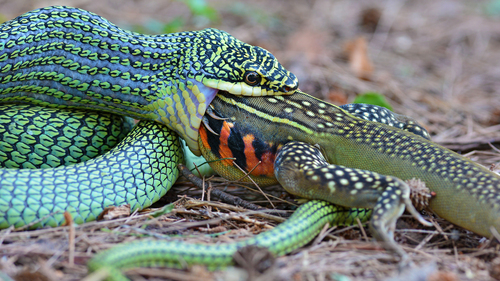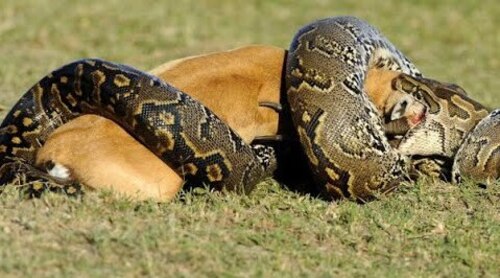When you think of snakes, you probably imagine them swallowing a mouse or a frog. But did you know that some snakes can take on prey as large as deer or even crocodiles? Yep, nature’s noodle has a big appetite, and certain species of snakes have evolved to hunt, swallow, and digest animals that are shockingly large. Let’s dive into the fascinating and jaw-dropping world of snake dining habits!

The size of the prey depends on the snake’s species, habitat, and physical size. Here are some of the larger animals that snakes are known to eat:
Mammals:
Deer: Large pythons, such as the Burmese python and reticulated python, have been seen swallowing adult deer whole.
Monkeys: In rainforest habitats, pythons sometimes target primates like monkeys.
Pigs and Goats: Farm animals, like wild pigs and small goats, are also on the menu for snakes living near rural areas.
Rodents: While not as shocking, snakes like boas can eat large rodents such as capybaras, the world’s biggest rodent.
Reptiles:
Crocodiles: Believe it or not, anacondas have been spotted swallowing young caimans (a type of crocodile) in the Amazon.
Lizards: Larger lizards like monitor lizards make a hearty meal for big snakes.
Birds:
Flamingos: Some snakes, like the African rock python, have even eaten flamingos! Their long necks make for an unusual meal.
Waterbirds: Ducks and geese are common prey for snakes living near water.

Snakes have an incredible ability to eat animals much larger than their heads. Here’s how:
Flexible Jaws:
A snake’s lower jaw isn’t fused like ours. Instead, it’s connected by stretchy ligaments that allow it to expand. This means they can swallow prey several times wider than their own body.
Slow and Steady:
Snakes don’t chew. They use their curved teeth to grip the prey, then slowly “walk” their jaws over it, inching the animal into their stomach.
Digestive Superpower:
Once the prey is swallowed, snakes release powerful stomach acids that can break down meat and even bone. Digestion can take days or weeks, depending on the size of the meal.
In Florida, a Burmese python was found to have swallowed a deer weighing over 30 pounds.
Anacondas in South America have been photographed eating capybaras, wild pigs, and even jaguar cubs.
Videos of pythons attempting to eat crocodiles often go viral, showcasing nature’s brutal reality.
After eating a large animal, snakes can go weeks—or even months—without eating again. The larger the meal, the longer it takes to digest. For instance:
A small mammal may take a few days.
A deer or crocodile can take several weeks to fully digest.
Big meals aren’t without risks. Sometimes, the prey fights back:
Injuries: Large prey like wild pigs or deer can kick or bite, injuring the snake.
Overestimation: Some snakes try to eat prey too large, leading to suffocation or internal injuries.
Eating large prey means snakes can conserve energy. Instead of hunting frequently, they can eat one large meal and rest for weeks. This is especially useful in environments where food is scarce.
Large snakes play a crucial role in their ecosystems by controlling populations of mammals, birds, and other reptiles. However, their appetite for large prey sometimes brings them into conflict with humans, especially when they prey on farm animals.
Q: What’s the biggest animal a snake has ever eaten?
A: Some of the largest meals recorded include deer, crocodiles, and even cattle.
Q: Can a snake eat something bigger than itself?
A: While snakes can eat prey much wider than their bodies, the prey’s overall size is usually limited by the snake’s length and jaw flexibility.
Q: Do snakes eat humans?
A: It’s extremely rare, but there have been cases where large pythons in Southeast Asia have attacked and eaten humans.
Q: How do snakes hunt large prey?
A: Snakes use ambush tactics, coiling and constricting their prey to suffocate them before swallowing.
Snakes are nature’s most efficient predators, capable of eating animals much larger than themselves. From wild pigs and deer to crocodiles and monkeys, their ability to hunt and consume big prey is a testament to their evolutionary adaptations. While it’s fascinating, it also serves as a reminder of the balance of nature and the powerful role snakes play in their ecosystems.
Next time you see a snake, remember—they’re not just eating bugs and mice. Some of them are taking on meals that could rival their own size!
animal tags: Snakes
We created this article in conjunction with AI technology, then made sure it was fact-checked and edited by a Animals Top editor.